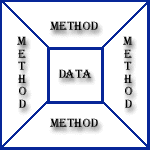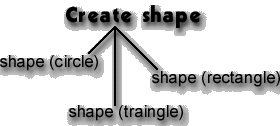Simplifying Object Oriented Programming
Object Oriented Programming is the most dramatic innovation in software development in the last decade. It ranks in importance with the
development of the higher-level languages at the dawn of the computer age. Sooner or later every programmer will be affected by the object oriented approach to program design. An object is a self-contained element of a computer program that
represents a related group of features and is designed to accomplish specific tasks. Objects also called instances. Each objects has specific role in a program, and all objects can work with other objects in defined ways.
The fundamental idea behind object-oriented language languages is to combine into a single unit both data and the functions that operate on the data. Such a unit is called an object. An object's functions, called member
functions in C++, typically provide the only way to access its data. If you want to read a data item an object. It will read a data and return the value to you. You can't access the data directly. The data is hidden, so it is safe from accidental alteration. Data and its functions are said to be encapsulated into a single entity. Data encapsulation and data hiding are key
termed in the description of object-oriented languages. Objects-oriented programming is modeled in the observation that in the real world, objects are, made up of many kinds of smaller objects.
However, the capability to combine objects is only a general aspect of object-oriented programming. It also includes concepts and features that make the creation and use of objects easier and more flexible. The most important of these feature is the class.
A class is a template used to create multiple objects with similar features. Classes embody all features of a particular set of objects. When you write a program in an object-oriented language. You don't define individual objects.
Instead, you define classes of objects.
The Three OOP Principles
All object-oriented programming languages provide mechanisms that help you implement the object-oriented model.
They are:
 Encapsulation is the mechanism that binds together code and the data if manipulates, and keeps both safe from outside interference and misuse. One way to think about encapsulation is as a protective wrapper that prevents the code and data from being arbitrarily accessed by other code defined outside the wrapper. Access to the code and data inside the wrapper is tightly controlled through a well-defined
interface. Conclusion: The wrapping up of data and methods into a single unit (called class) is known as encapsulation.
Encapsulation is the mechanism that binds together code and the data if manipulates, and keeps both safe from outside interference and misuse. One way to think about encapsulation is as a protective wrapper that prevents the code and data from being arbitrarily accessed by other code defined outside the wrapper. Access to the code and data inside the wrapper is tightly controlled through a well-defined
interface. Conclusion: The wrapping up of data and methods into a single unit (called class) is known as encapsulation.
Examples
C++
#include<iostream.h>
#include<conio.h>
class one
{
private:
int a;
public:
void printdata()
{
a = 7;
cout<<"Value of a is "<<a;
}
};
void main()
{
clrscr();
one b;
cout<<"Now I am in main function and going to call a function from class one";
b.printdata();
getch();
}
Java
class one
{
int a;
void printdata()
{
a = 7;
System.out.println("Value of a is " + a);
}
}
class incap
public static void main(String[] args)
{
one b = new one();
System.out.println("Now I am in main function and going to " +
"call a function from class one");
b.printdata();
}
}
 Inheritance is the process by which object of one class acquires the properties of another class. Inheritance supports the concept of hierarchical classification. For example, the atlas is a part of class
bicycle, which is again a part of the class cycle. As illustrated in the principal behind this sort of division is that each derived class shares common
characteristics with the class from which it is derived. In OOP, the concept of inheritance provides the idea of reusability. This means that we can add additional features to an existing class without modifying it. This is possible deriving a new class from the existing one. The new class will have the combined features of both the classes. Thus the real appeal and power of the inheritance mechanism is that allows the programmer to reuse a class that is almost, but not exactly, what he wants, and to tailor the class is such a way that is does not introduce any undesirable side effects into the rest of the class. The drive class is knows as 'subclass'.
Inheritance is the process by which object of one class acquires the properties of another class. Inheritance supports the concept of hierarchical classification. For example, the atlas is a part of class
bicycle, which is again a part of the class cycle. As illustrated in the principal behind this sort of division is that each derived class shares common
characteristics with the class from which it is derived. In OOP, the concept of inheritance provides the idea of reusability. This means that we can add additional features to an existing class without modifying it. This is possible deriving a new class from the existing one. The new class will have the combined features of both the classes. Thus the real appeal and power of the inheritance mechanism is that allows the programmer to reuse a class that is almost, but not exactly, what he wants, and to tailor the class is such a way that is does not introduce any undesirable side effects into the rest of the class. The drive class is knows as 'subclass'.
Examples
C++
#include<iostream.h>
#include<conio.h>
class one
{
public:
void test()
{
cout<<"Hello from class one";
}
};
class two : public one
{
public:
void test()
{
cout<<"Hello from class two";
one::test();
}
};
void main()
{
clrscr();
two t;
cout<<"Hello from main function";
t.test();
getch();
}
Java
import java.awt.*;
import javax.swing.*;
import java.awt.event.*;
public class dasForm extends JFrame
{
public dasForm()
{
super("Shankar Das");
}
public static void main(String[] args)
{
JFrame frame = new dasForm();
WindowListener w = new WindowAdapter()
{
public void windowClosing(WindowEvent e)
{
System.exit(0);
}
};
frame.addWindowListener(w);
frame.pack();
frame.setVisible(true);
frame.setSize(180,80);
}
}
 Polymorphism is a feature that allows one interface to be used for a general class of actions. The specific action is determined by the exact nature of the solution. Polymorphism means the ability to take more than one form. For example, consider the operation of addition. For two numbers, the operation will generate the sum. If the operands are three numbers, then the operation would produce the product of them. That a single function name can be used to handle different number and different arguments. This is something similar to a particular word having several different meanings depending on the context. Polymorphism plays an important role in allowing objects having different internal structures to share the same external interface. This means that a general class of operations may be accessed in the same manner even though specific actions associated with each operation may differ. Polymorphism is extensively used in implementing inheritance.
Polymorphism is a feature that allows one interface to be used for a general class of actions. The specific action is determined by the exact nature of the solution. Polymorphism means the ability to take more than one form. For example, consider the operation of addition. For two numbers, the operation will generate the sum. If the operands are three numbers, then the operation would produce the product of them. That a single function name can be used to handle different number and different arguments. This is something similar to a particular word having several different meanings depending on the context. Polymorphism plays an important role in allowing objects having different internal structures to share the same external interface. This means that a general class of operations may be accessed in the same manner even though specific actions associated with each operation may differ. Polymorphism is extensively used in implementing inheritance.
Examples
C++
#include<iostream.h>
#include<conio.h>
#include<graphics.h>
class poly
{
private:
int gd,gm;
public:
void graph()
{
gd=DETECT;
initgraph(&gd,&gm,"");
}
void draw(int a)
{
cleardevice();
circle(getmaxx()/2,getmaxy()/2,a);
getch();
}
void draw(int a, int b)
{
cleardevice();
rectangle(getmaxx()/2-a/2,getmaxy()/2-b/2,
getmaxx()/2+a/2,getmaxy()/2+b/2);
getch();
}
};
void main()
{
clrscr();
poly p;
p.graph();
p.draw(50);
p.draw(50,50);
closegraph();
}
Java
class plm
{
void hello(String s)
{
System.out.println("My name is " + s);
}
void hello(String s, int ag)
{
System.out.println("My name is " + s + " & Age is " + ag);
}
void hello(String s, int ag, String ct)
{
System.out.println("My name is " + s + " & age is " + ag);
System.out.println("I am from " + ct + " city");
}
}
class polymor
{
public static void main(String[] agrs)
{
plm p = new plm();
p.hello("Shankar Das");
p.hello("Shankar Das",25);
p.hello("Shankar Das",25,"Bhopal");
}
}
Encapsulation, Inheritance and Polymorphism Work Together
When properly applied polymorphism, encapsulation and inheritance combine to produce a programming environment that support the development of far more robust and scaleable programs than does the process-oriented model. A well-designed hierarchy of classes is the basis for reusing the code in which you have invested time and effort developing and testing. Encapsulation allows you to migrate your implementations over
time without breaking the code that depends on the public interface of your classes. Polymorphism allows you to create clean, sensible, readable and resilient code.
This member has not yet provided a Biography. Assume it's interesting and varied, and probably something to do with programming.
 General
General  News
News  Suggestion
Suggestion  Question
Question  Bug
Bug  Answer
Answer  Joke
Joke  Praise
Praise  Rant
Rant  Admin
Admin 







